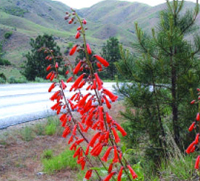
|
CONNECTIONS
|
IDAHO
ITD
HOME
IDAHO DMV
ITD NEWS
HIGHWAY
SAFETY
IDAHO STATE
POLICE
TRAVEL SERVICES
STATE OF IDAHO
NATIONAL
AASHTO
AAMVA
AAA of IDAHO
FEDERAL HIGHWAYS
FEDERAL AVIATION
IDAHO STATE POLICE
NHTSA
NTSB
TRB
U.S. DOT
Idaho
Transportation
Department
Public Affairs Office
P.O. Box 7129
Boise, ID 83707
208.334.8005
Fax: 208.334.8563
Email

ITD
photos included in FHWA publication
The following was submitted by ITD's Cathy Ford, roadside program administrator, and Sheri Sweaney, volunteer services coordinator. It appeared in the Federal Highway Administration's quarterly newsletter "Green Roadsides," posted online Friday, May 20. To view the publication, go to: http://www.fhwa.dot.gov/environment/greenerroadsides/spring05.htm
---------------------

Idaho's Integrated Vegetation Management
Whether for their beauty, drought tolerance, or hardiness, native plants are being utilized by many land managers to enhance plant diversity, restore native habitats, and promote long-term healthy plant communities. When planted in their native environments under appropriate conditions, native plants can be very hardy, and rarely need additional water or fertilizer. Native plants can also compete with and reduce undesirable or invasive plants that have adapted to disturbed conditions with limited water or nutrient resources.
 ITD’s
goal is to be responsible land managers and neighbors and promote responsible
stewardship on all roadsides, roadways and ITD property. We strive to
successfully manage noxious and invasive weeds, and reduce the negative
impact they have on our environment. ITD is continually developing and
promoting a comprehensive integrated roadside management program, which
includes establishing sustainable vegetation (native and other adaptable
and perennial vegetation) along all roadsides that is attractive in
appearance and requires only minimal maintenance.
ITD’s
goal is to be responsible land managers and neighbors and promote responsible
stewardship on all roadsides, roadways and ITD property. We strive to
successfully manage noxious and invasive weeds, and reduce the negative
impact they have on our environment. ITD is continually developing and
promoting a comprehensive integrated roadside management program, which
includes establishing sustainable vegetation (native and other adaptable
and perennial vegetation) along all roadsides that is attractive in
appearance and requires only minimal maintenance.
Achieving a successful integrated roadside vegetation management program requires planning, implementation, control, and coordination of many roadside activities. ITD currently uses such management practices as mowing to reduce seed production and dispersal of undesirable plants, selective herbicide treatments to control large weed-infested areas, biological control agents to reduce the spread of invasive species in restricted or highly sensitive areas, mechanical and hand pulling methods to maintain appropriate plant height and encourage desirable vegetation, as well as planting native and adaptable vegetation to enhance long-term healthy plant communities.
 Planting
and seeding native species is part of our revegetative effort to restore
and reintroduce natives because they adapt to soil and environmental
conditions and have a greater resistance to pests and disease. In addition,
other desirable or non-native plants are used because they establish
quickly, reduce erosion problems and compete with other invasive species.
We also use compost and other organic mulches to provide essential nutrients,
and growing mediums that facilitate establishment of desirable plants.
Planting
and seeding native species is part of our revegetative effort to restore
and reintroduce natives because they adapt to soil and environmental
conditions and have a greater resistance to pests and disease. In addition,
other desirable or non-native plants are used because they establish
quickly, reduce erosion problems and compete with other invasive species.
We also use compost and other organic mulches to provide essential nutrients,
and growing mediums that facilitate establishment of desirable plants.
Another important aspect of ITD’s integrated vegetation management program is working with universities to develop better techniques and sound practices for reducing erosion and promoting perennial vegetation establishment. We are currently working on a native plant research project that increases opportunities for reintroducing native plants along state highways and Interstates to control erosion and reduce sedimentation, maintenance costs, and the spread of noxious weeds. Native plants enhance slope stability by providing plant species with varying rooting depths to prevent surface shearing and slope failures.
The reintroduction of native plant species also provides opportunities to improve natural habitats, enhance species diversity and develop native plant gardens in rest areas. This study will allow us to determine the most effective and practical plant propagation methods to achieve native plant establishment on drastically altered or disturbed areas, road construction projects, and native plant gardens within rest areas. A Native Plant Guide is being developed to assist land managers in selecting appropriate native species that are well suited for roadside revegetation.
The guide will be a valuable tool for ITD personnel when selecting appropriate native plant species for slope stabilization, erosion control and sediment management, as well as highway beautification along roadsides in Idaho. This publication is scheduled to be completed this fall.